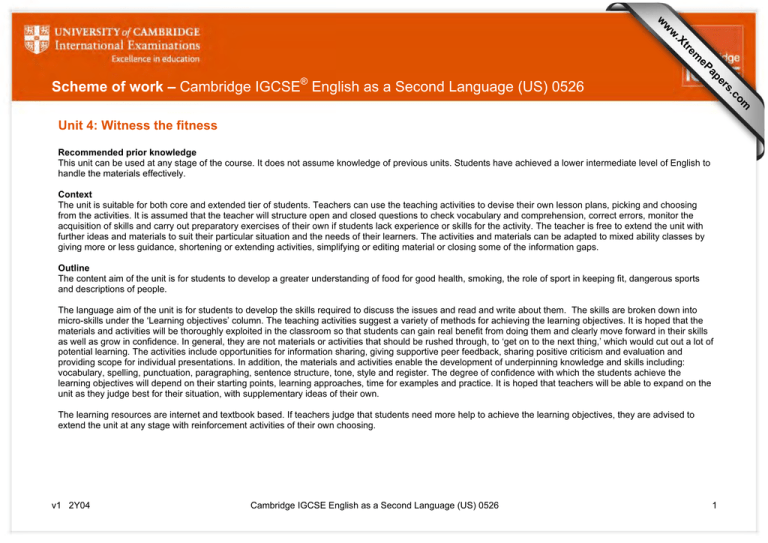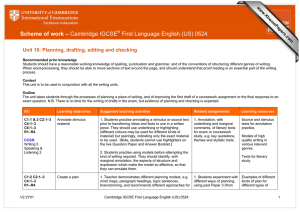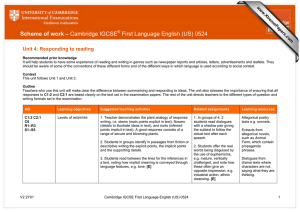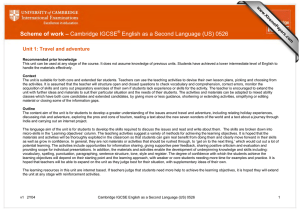Scheme of work – Cambridge IGCSE Unit 4: Witness the fitness
advertisement

om .c s er ap eP m e tr .X w w w Scheme of work – Cambridge IGCSE® English as a Second Language (US) 0526 Unit 4: Witness the fitness Recommended prior knowledge This unit can be used at any stage of the course. It does not assume knowledge of previous units. Students have achieved a lower intermediate level of English to handle the materials effectively. Context The unit is suitable for both core and extended tier of students. Teachers can use the teaching activities to devise their own lesson plans, picking and choosing from the activities. It is assumed that the teacher will structure open and closed questions to check vocabulary and comprehension, correct errors, monitor the acquisition of skills and carry out preparatory exercises of their own if students lack experience or skills for the activity. The teacher is free to extend the unit with further ideas and materials to suit their particular situation and the needs of their learners. The activities and materials can be adapted to mixed ability classes by giving more or less guidance, shortening or extending activities, simplifying or editing material or closing some of the information gaps. Outline The content aim of the unit is for students to develop a greater understanding of food for good health, smoking, the role of sport in keeping fit, dangerous sports and descriptions of people. The language aim of the unit is for students to develop the skills required to discuss the issues and read and write about them. The skills are broken down into micro-skills under the ‘Learning objectives’ column. The teaching activities suggest a variety of methods for achieving the learning objectives. It is hoped that the materials and activities will be thoroughly exploited in the classroom so that students can gain real benefit from doing them and clearly move forward in their skills as well as grow in confidence. In general, they are not materials or activities that should be rushed through, to ‘get on to the next thing,’ which would cut out a lot of potential learning. The activities include opportunities for information sharing, giving supportive peer feedback, sharing positive criticism and evaluation and providing scope for individual presentations. In addition, the materials and activities enable the development of underpinning knowledge and skills including: vocabulary, spelling, punctuation, paragraphing, sentence structure, tone, style and register. The degree of confidence with which the students achieve the learning objectives will depend on their starting points, learning approaches, time for examples and practice. It is hoped that teachers will be able to expand on the unit as they judge best for their situation, with supplementary ideas of their own. The learning resources are internet and textbook based. If teachers judge that students need more help to achieve the learning objectives, they are advised to extend the unit at any stage with reinforcement activities of their own choosing. v1 2Y04 Cambridge IGCSE English as a Second Language (US) 0526 1 AO and CCSS Learning objectives Suggested teaching activities Learning resources Reading: Reading: Fresh fruit and vegetables for good health. Eating for good health. Reading text: Fresh fruit and vegetables for good health. Fresh fruit and vegetables for good health: www.bbc.co.uk/worldservice/learningen glish/newsenglish/witn/031110_witn.sht ml R1 Respond to information presented in a variety of forms R4 Infer information from texts (Extended only) CCSS: Literature 4 Informational Text 1, 2, 6, 8 Language 3 Word building strategies: Students are able to identify and use prefixes and suffixes to make new words in various grammatical categories. Inferences: Students are able to draw an appropriate inference from the text. Students read and discuss the text which is about why we should eat five portions of fruit and vegetables each day. The text can be used to explore how students make sure they eat well and how far they agree with the idea that organisations have the right to advise us on our most personal decisions such as what to eat. Inferences can be drawn from the text about the possible inequities involved in poor areas being the main producers of fruit and vegetables without being a major consumer of them. Teachers can set their own questions for comprehension. Attention can be drawn to the word building patterns in use, including prefix, suffix, root word and grammatical category-adjective, noun etc. Students can identify the root word from the word given in the article (consumption-consume), They can suggest other words which have the same suffix e.g. attend/attention. They can identify whether the new word is a verb, adjective, noun etc. and provide example sentences. They can identify the suffixes used in a range of other adjectives in the text e.g. ‘obesity’, ‘fatty’, ‘salty’, ‘global’, ‘unhealthy’, ‘preventable’, ‘convenience’ and write sentences to show their meaning. v1 2Y04 Cambridge IGCSE English as a Second Language (US) 0526 2 AO and CCSS Learning objectives Suggested teaching activities Learning resources Speaking: Presenting an effective spoken argument: Cigarette smoking – the right to choose. Cigarette smoking – the right to choose No smoke without fire: www.tefl.net/esl-lesson-plans/eslworksheets-tp.htm Students will be able to use a suitable register to present their argument to their target audience, using more formal features, such as speaking in complete sentences, using precise vocabulary. Students are able to use conjunctions and markers such as ‘therefore’, ‘on the contrary’, which show logical and sequential links between ideas. Students are able to relate to the target audience explicitly e.g. As parents you will be concerned about… The questions on the worksheet are wide-ranging and detailed and can be used to explore the rights and wrongs of smoking, the motivation to smoke, the health risks, government involvement in promoting smoking and so on. S1 Communicate clearly, accurately and appropriately S2 Convey information and express opinions effectively S3 Employ and control a variety of grammatical structures S4 Demonstrate knowledge of a range of appropriate vocabulary L1 Understand and respond to information presented in a variety of forms L2 Recognise, understand and distinguish between facts, ideas and opinions CCSS: Speaking & Listening 1, 3, 4, 6 Language 3 Discussion based on worksheet: ‘No smoke without fire.’ Students will be able to listen closely to the speaker and ask relevant questions to check theories etc. Reading: Making notes: Reading and taking notes: R1 Respond to information presented in a variety of forms Students are able to be selective and identify the key points in a text. Stop them before they start. Students can read the text about scientists who are currently working on a vaccine for young children which will inoculate them from becoming addicted to smoking. This works by blocking the pleasure receptors in the brain which are stimulated by nicotine, so smoking is unlikely to give the pleasure which leads to craving. The students R2 Select and organise material relevant to specific purposes v1 2Y04 Cambridge IGCSE English as a Second Language (US) 0526 Summary and Note-taking Georgian Press Revised edition Page 14 ISBN: 9781873630525 3 AO and CCSS Learning objectives Suggested teaching activities Learning resources explore the moral and ethical concerns, pros and cons of the vaccine. CCSS: Literature 4 Informational Text 2 Language 3 Students can discuss the style of the text which is rather neutral and non-dramatic, even though it is a controversial issue. When students complete the note-taking exercise, they can discuss the importance of clear, concise notes. Notes do not need to be complete sentences and students can discuss the importance of not copying long pieces from the text. Students could also compare two sets of notes: one good, one poor and analyse why one set is better than the other. Speaking: S1 Communicate clearly, accurately and appropriately S2 Convey information and express opinions effectively S3 Employ and control a variety of grammatical structures S4 Demonstrate knowledge of a range of appropriate vocabulary S5 Engage in and influence the direction of the conversation S6 Employ suitable pronunciation and stress v1 2Y04 Role play: Organising a campaign. Students are able use expressions for agreeing and disagreeing, expressing views, persuading, advising, contributing to a discussion and moving it forward. Organising a campaign: Students are able to assume roles in a role play, make constructive contributions, produce ideas and develop the ideas of others, and speak clearly with a suitable intonation and stress. They know that directly expressed disagreement is unusual and are able to apply this knowledge to work co-operatively in groups. Presenting an effective argument: Students can extend the smoking vaccine topic by presenting a reasoned argument to a target audience, such as a group of parents, as to whether the vaccine should be compulsory for children or not. Students can explore the type of register to be used, aspects of audience awareness, ways of giving reasoned examples and the use of discourse markers. Students present their talks to the group. The group respond as though they were parents. Role play: Organising a campaign As part of health awareness, students imagine that their school wants to start an effective anti-smoking campaign. Students work in groups to brainstorm ideas about campaigning strategies e.g. videos, talks, posters etc. They have to list in order of priority the activities they will undertake. Expressions for agreement (That’s a good point…) or disagreement, (That’s not how I see it) expressing Cambridge IGCSE English as a Second Language (US) 0526 4 AO and CCSS Learning objectives Suggested teaching activities Learning resources opinions, giving advice (We should, we could), persuading (I really think we need to…) and taking part in a discussion (We need to think about how we can…) are first elicited, repeated, and practised in example sentences. They may be written on the board for reference during the role play. patterns CCSS: Speaking & Listening 1, 4, 6 Students can discuss how disagreement is rarely expressly directly e.g. (You’re wrong/I don’t agree with you at all). Reading: R1 Respond to information presented in a variety of forms R2 Select and organise material relevant to specific purposes R3 Recognise, understand and distinguish between facts, ideas and opinions CCSS: Literature 4 Informational Text 1, 2, 6, 8 Language 3 v1 2Y04 Reading strategies: Newspaper report: Women fight to be Sumos Students are able to use the title and picture to predict meaning. Students are able to skim and scan to locate details and information. Students are able to distinguish fact from opinion. The role of sport in keeping fit: Newspaper report: Women fight to be Sumos. Women fight to be Sumos: www.bbc.co.uk/worldservice/learningen glish/newsenglish/witn/2006/02/060227 _women_sumo.shtml The text is about two women who are training to compete against the top female sumo wrestlers in Japan. Apart from being an interesting text in itself, it provides scope for students to discuss whether boys and girls have different attitudes to sport and why. Opinions and views presented in the text, such as whether women are mentally tougher than men and as capable of generating aggression, can be explored in terms of the facts and evidence that exists in the world in general, to back up or refute these ideas. Students can use the photograph and title to decide whether the material is of interest and predict meaning. They can find four things that Jackie Bates likes about the sport and asked to skim read the text quickly to find answers. They can also practise scanning for precise, specific information such as how old Jackie is or what her job is. Cambridge IGCSE English as a Second Language (US) 0526 5 AO and CCSS Learning objectives Suggested teaching activities Learning resources Listening: Recorded announcement: Listening skills: L1 Understand and respond to information presented in a variety of forms Students are able to listen for specific detail in an announcement, recognise and follow recorded instructions, including times and places. Listening to a recorded announcement. Success International English Skills for IGCSE Georgian Press Unit 3 Page 43 ISBN: 9781873630440 L3 select and organise material relevant to specific purposes Students understand and follow the use of compound nouns. CCSS: Speaking & Listening 3 Language 3 Sports centre. Students listen to a recorded announcement about some facilities available at a sports centre and complete a diary in note form. Students can first share their ideas of their experiences of sports centres and say what they like or dislike about them. You could ask whether students find the fact that the swimming pool is closed when they want to use it is frustrating, for example. Discussion on the use of compound nouns can be developed beforehand e.g. ‘changing room’, ‘application form’, ‘open-air pool’, and other examples elicited, repeated and used in example sentences. Students can talk about what they think they will hear on the sports centre announcement. Students may need to listen up to three times to complete the diary; the recording may be paused for checking where necessary. Reading: R1 Respond to information presented in a variety of forms R2 Select and organise material relevant to specific purposes Reading strategies: Record Breaking Boxer returns Figurative meanings: Students are able to identify and use words in a figurative and literal context. Comparatives and superlatives: CCSS: Literature 4 Informational Text 2 Language 3 v1 2Y04 Students are able to identify and use the comparative and superlative structures. Dangerous sports: Boxing Record Breaking Russian Boxer returns BBC Learning English The text is about the return of a Russian boxer - the tallest and heaviest world boxing champion in the history of the sport. Record Breaking Russian Boxer Returns: www.bbc.co.uk/worldservice/learningen glish/newsenglish/witn/2005/12/051226 _valuev.shtml The text provides good examples of figurative language such as ‘towers over his opponents,’ ‘punch his way to victory’ which students can explore. Students can highlight figurative language with a highlighter pen. They can suggest other words with Cambridge IGCSE English as a Second Language (US) 0526 6 AO and CCSS Learning objectives Suggested teaching activities Learning resources literal/non-literal meanings; example sentences can be explored and written on the board. Students can use highlighter pens to identify comparatives and superlatives in the text and discuss the formation of comparatives and superlatives. Example sentences can be elicited, repeated and practised. Students can explore whether violent sports encourage aggressive behaviour or discourage it, because they provide a safe outlet for pent-up emotion. They can also explore the value of team sports. Teachers can write their own comprehension questions. Writing: W1 Communicate clearly, accurately and appropriately W2 Convey information and express opinions effectively W3 Employ and control a variety of grammatical structures W4 Demonstrate knowledge of a range of appropriate vocabulary W5 Observe conventions of paragraphing, punctuation, spelling v1 2Y04 Writing activity: A description of a person Success International English Skills for IGCSE Writing Activities: a description of a person. Students are able to choose a range of varied vocabulary for describing a person. They are able to use intensifiers, clauses etc. Students brainstorm ideas, plan and draft an outline description of someone they like or admire. The description can be targeted at describing a friend for a school newsletter or describing someone they know for a friendship agency or recommending someone for an award. Students are able to identify the positive and negative connotations of adjectives and judge what is most appropriate to use. Students are able to use a range of structures and an appropriate register for the target audience. Success International English Skills for IGCSE Writing Activities Revised Edition Georgian Press Unit 1 Pages 20–23 ISBN: 9781873630440 Vocabulary for describing appearance and character can be elicited. The positive and negative connotations of a word e.g. ‘skinny’/‘shy’ can be elicited and further examples discussed. Sample basic sentences can be elicited and then improved by students’ suggestions e.g. ‘she has brown hair’ can be made more engaging by further adjectives e.g. long/wavy or adding clauses such as ‘which is often tied back into a pony tail. Cambridge IGCSE English as a Second Language (US) 0526 7 AO and CCSS W6 Employ appropriate register/style CCSS: Writing 1, 2, 3, 4 Language 1, 2, 3, 4, 6 v1 2Y04 Learning objectives Suggested teaching activities Learning resources Students could consider examples of tone and style elicited from students – writing should sound enthusiastic and positive and negative points of the person should be avoided or justified. Less able students would find analysing a worked example of a description of a person particularly helpful for guidance before starting to put their own description together. Cambridge IGCSE English as a Second Language (US) 0526 8




